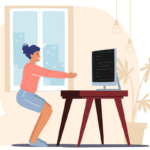Let’s face it, it’s been a tough couple of years. Worries around the pandemic, financial stress, disruption and uncertainty have all put a greater strain on mental health, but also promoted greater awareness. On top of this, the increased darkness during the winter can have a profound effect on well-being for many. As the days get darker and shorter and temperatures begin to drop, so can your outlook. I’ve witnessed these changes in my loved ones impacted by this, a type of depression known as seasonal affective disorder (SAD).
While SAD can occur during the summer months, it’s far more common during winter. People typically experience it starting in the fall, lasting through the winter months. As the seasons change gradually, symptoms may also start slowly and worsen over time, typically lasting 4-5 months.
Changes in mood like SAD can be difficult to pin down. However, SAD does have a couple defining factors, it starts around the same time each year with similar triggers and follows this seasonal pattern for at least two consecutive years.1
Seasonal Affective Disorder Impact
SAD affects about five percent of adults in the U.S. with January and February usually being the most difficult. In the U.S., SAD is more common in northern regions that experience darker winters.2
I can see it taking its toll on myself and the people I love both mentally and physically. For some it’s an increase in anxiety, a loss of interest in daily activities we used to look forward to. Some experience joint and muscle pain from their head to their toes. Some overeat, oversleep and experience a loss of energy. These symptoms are specific to winter-pattern SAD. However it manifests, we need to know the signs, and recognize when it’s not just the winter blues.
Symptoms of SAD can include:3
- Feeling depressed most of the day, nearly every day
- Losing interest in activities you once enjoyed
- Having problems with sleep
- Feeling sluggish or agitated
- Having low energy
- Feeling hopeless or worthless
- Having difficulty concentrating
- Having frequent thoughts of death or suicide
- Oversleeping (hypersomnia)
- Overeating, particularly with a craving for carbohydrates
- Weight gain
- Social withdrawal (feeling like “hibernating”)
Seasonal Affective Disorder Causes
Research indicates that it may be related to the balance of brain chemicals, specifically serotonin and melatonin. Serotonin helps to regulate mood, and its production is understood to be influenced by exposure to sunlight. If someone has reduced exposure to sunlight, like during the winter in northern areas, or if their body doesn’t properly produce serotonin, this can lead to decreased serotonin levels, which in turn can lead to mood disorders like SAD.4
Seasonal Affective Disorder Treatments
If you feel you have symptoms of SAD, talk to your doctor, psychiatrist or other trained medical professional. They may suggest one of several treatment options. As with major depressive disorder, cognitive behavioral therapy or antidepressants may be prescribed.
Light therapy can help reduce symptoms of seasonal affective disorder.
Light therapy using special therapy lamps has also shown effectiveness in reducing SAD symptoms. This involves using a bright light to simulate exposure to the sunlight that’s missing during the winter months. The lamp should produce at least 10,000 lux, a measure of light intensity. A bright sunny day is 50,000 lux or more. Experts recommend placing the light off to the side about a foot away for about 30 minutes. This exposure is most effective within an hour of waking up if possible or before 10 a.m.5
Experts recommend strong light exposure in the morning, but for those living in areas with darker winters, this may be easier said than done. Often we may find ourselves waking or heading to work in the dark and driving home in the dark with little opportunity for sun exposure. In these cases, it’s best to find time to get outside around noon or early afternoon when the sunlight is strongest. Even on a cloudy day, 15 minutes can help boost mood.
Sometimes friends and family can notice the changes in mood and behavior before those living with SAD realize it’s happening. I try to recognize these signs in my loved ones and encourage changes that have helped previously, like:
- Do something that makes you feel good first thing in the morning.
- Establish and maintain a routine.
- Do yoga class or a guided meditation.
- Get a good night sleep and try to eat a balanced diet.
- Surround yourself with positive people and take a break from anyone who brings you down.
- Increase exposure to light.
Feeling down during certain seasons shouldn’t mean missing out on half the year. By noticing and acknowledging symptom patterns and triggers, those experiencing SAD can talk to their doctor about treatment.
If you or someone you know is in immediate distress or is thinking about hurting themselves, call the National Suicide Prevention Lifeline toll-free at 1-800-273-TALK (8255). You also can text the Crisis Text Line (HELLO to 741741) or use the Lifeline Chat on the National Suicide Prevention Lifeline website.
1 National Institute of Mental Health, “Seasonal Affective Disorder”
3 American Psychiatric Association, “Seasonal Affective Disorder (SAD)”
3 National Institute of Mental Health, “Seasonal Affective Disorder”
4 National Institute of Mental Health, “Seasonal Affective Disorder”
5 Harvard Medical School, “Shining a Light on Winter Depression”














